
I first read about Ricki Carroll and her company in Barbara Kingsolver's Animal, Vegetable, Miracle
So this afternoon, after reading the opening chapters in my cheesemaking book, and having read and re-read the recipe for mozzarella (per my own guidelines for complicated cooking), and making sure I had all the necessary ingredients and equipment, I decided to give it a shot. How hard could it be?
You've heard that whole "pride cometh before a fall" bit, right? Yeah.
To start with, I dissolved my rennet and lactic acid in water. Easy!

Then I poured my gallon of milk into my big stainless steel pot. Uh-oh. Here's where it got complicated. (Already??) So I had stopped at my local grocery store to pick up some milk for this venture. Normally, we only buy organic milk, but -- having read my cheese book -- I knew I couldn't use ultra-pastuerized milk to make cheese. Turns out, all of the organic milk at my local store was ultra-pastuerized. So I bought a gallon of store-brand milk and hoped for the best. What I was hoping was that the particular brand would not have heated the milk past 174 degrees. This is the point at which milk proteins start to break down, and the dairies don't have to label it any differently unless it's been heated to ultra-pateurization temps (191 degrees and up). Overheated milk won't form a strong curd, and ultra-pasteurized won't work at all. Never having done this before, and having no way of knowing how much my milk had been heated or for how long, I had to cross my fingers.
So, for better or for worse, I had a pot full of milk. I had to stick my dairy thermometer into the pot so I could bring the milk to 90 degrees, and then later to 105 degrees. But I had no way of suspending the thermometer in the pot so that I could read the temperature of the milk, and not the sides or bottom of the pot. And I definitely did not have a free hand available to hold the dang thing! So, I improvised.
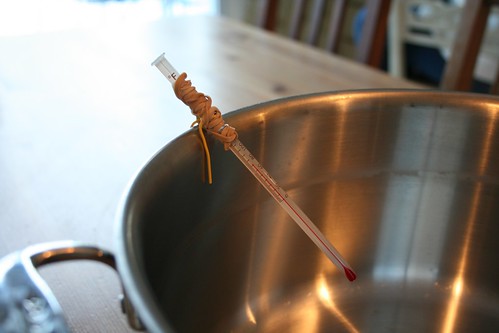
A paperclip and two rubber bands. Perfect!

I added the citric acid solution and hoped I was stirring vigorously enough. Then I put it on the stove and started bringing it to 90 degrees... while stirring! I was a pansy at first and had the burner on super low, afraid the milk would heat up too quickly or something (I don't know! I'm new at this!), so this took a bit longer than it's supposed to, I think. Eventually I cranked it up and we got goin'.

Then I removed the pot from the burner, stirred in the rennet solution, hoping I was distributing it evenly enough, and then covered the pot and left it alone for five minutes. A very loooong five minutes.
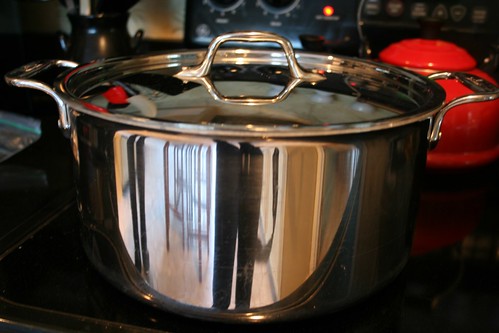
Then I checked it. It didn't look anything like the picture it was supposed to look like.

It didn't resemble custard. But... it didn't look like milk anymore either. Something was happening. Per the recipe, I left it alone for another five minutes, to see if it would set any harder. Nope. Still looking like cottage cheese floating in green liquid. A smart woman would have thrown in the dish towel right here, but not me. Nope. I soldiered on.

The recipe called for lifting the curds out of the pot. Ha! Not going to happen. Instead, I lined a colander with cheesecloth, and poured the whey off that way. With my husband cracking jokes the whole time ("No whey!"), and my five-year-old asking roughly every 12.6 seconds when we're going to get to the fun part, I finally got the curds into a bowl.
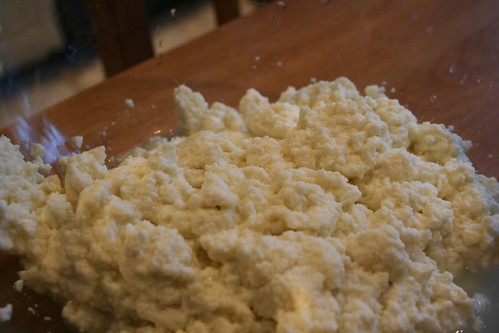
Definitely not what they're supposed to look like. But I stuck the bowl in the microwave anyway. I am an eternal optimist! Or a glutton for punishment -- one of the two. Anyhow, miracles do happen, because when I pulled it out of the microwave, it looked like this!

Well, well, well... look what we have here! Something that actually looks like the picture in the book! A miracle in the microwave! Holy cheese curds, Batman!
I then proceeded to knead the curds and heat a few more times in the microwave. (I now know I over-kneaded, because my finished product is a bit dry. Duly noted, and I will be gentler next time.) Then we got to stretch and shape it!
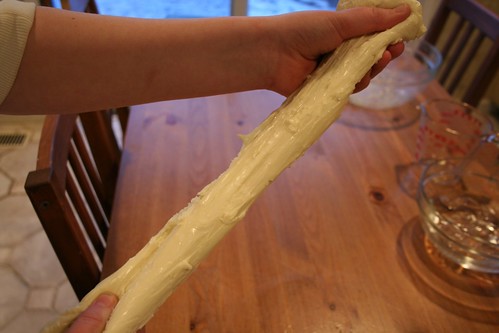
Here is where it comes in very handy to have daughters who like to help in the kitchen. The five-year-old even made her own string cheese!
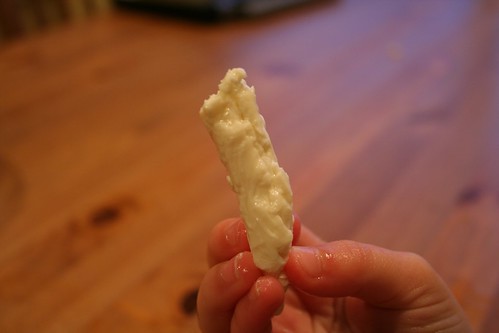
Our finished shapes went into an ice-water bath to set them.
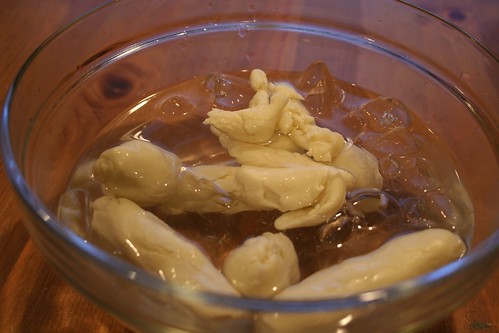
And... hooray! Finished mozzarella!
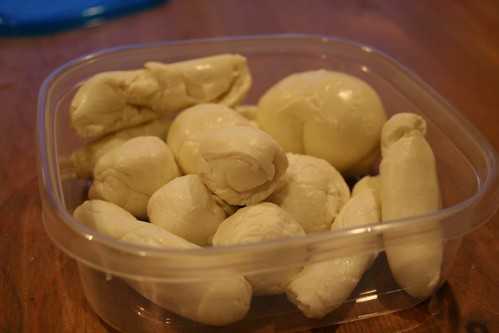
Somehow, it still worked. It's even, dare I say, delicious! But after doing some research on Ricki's website, I now know that my milk had probably been heated higher than normal pasteurization, probably something over 174 degrees. I will not attempt to make cheese with this brand again -- next time, I will make the schlep to Whole Foods, or better yet, to a local farm where I can buy fresh milk directly.
In the meantime, we're going to be munching mozzarella this week... and plotting our next adventure with curds and whey. This cheesemaking bit is addictive.
Awesome! Congratulations. Looks to me like it went quite well. You have the same book I do, but I've never used mine-- when I tried this project I was doing it with the Hearthsong mozzarella kit. Did you use cheese salt? I think that's usually added during the kneading stage. If not, how does it taste without it?
ReplyDeleteIt seems like a candy thermometer would hold to the side of the pot better.... do they make instant-read candy thermometers? That might be ideal.... I'm brainstorming for if I try this again. Your post is definitely inspiring (and I love the title). I clearly remember that my end product was.... wetter... yours looks like mozzarella you could actually grate, whereas mine was like the wetter, sold-in-a-tub version. I'm most impressed-- please update if you try it again with a different milk and/or ingredients.
What a thrill! I've been working with yoghurt and cheese made from draining the whey. I have to say I am very envious of your mozzerella! Thanks to your tutorial I have more confidence and will be attempting mozzerella sometime this year!
ReplyDeleteNO WAY! I read about this in Animal, Vegetable, Miracle a while ago and have not yet been brave enough to try. I had no idea that microwave cold be involved in cheese making!
ReplyDeleteThis is so cool! I love that you tried this and the terrific way in which you chronicled your adventure in cheesemaking. I have honestly never thought about making my own cheese, even after reading Animal, Vegetable, Miracle. (Cheesemaking and turkey butchering were two of the things at which I thought, she's a better woman than I!)
ReplyDeleteRebecca, I did use cheese salt -- whoops! forgot to mention that. :) I think I added it too early, and I think 1 tablespoon was too much -- it tastes salty to me -- but the kids insist it is perfect.
ReplyDeleteAnd Kerry, I'm with ya on the turkey butchering!! But I was embolded by that book to do a bunch of things I'd never considered before, including baking bread and making jam, both of which are chronicled ad nauseum here. :)